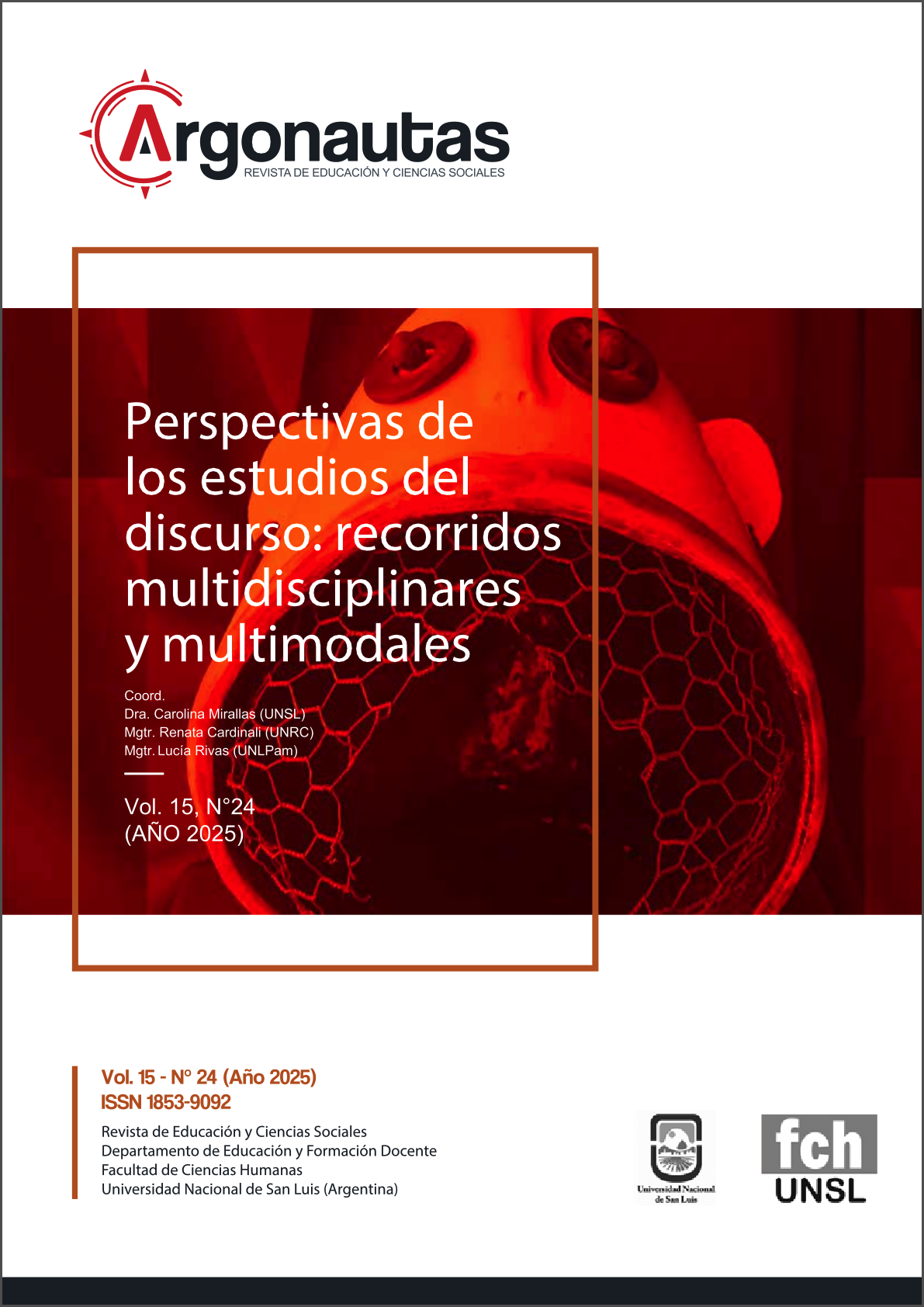Where did Milei's votes come from? The configuration of a disruptive enunciation device we did not see coming
Keywords:
political discourse analysis, semiotics, new right, enunciation device, MileiAbstract
In this essay-like analysis, we propose to address the case of Javier Milei, as an enunciator who emerged in the political sphere, establishing his legitimacy as a non-politician. Milei's emergence disrupted the established order of politics, understood as the set of practices and institutions through which a given order is created (Mouffe, 2011). The proposed approach will begin with an eclectic anchor in the field of discourse analysis and will pay attention to the emergence of this "new" enunciator in the political sphere: Javier Milei. This concomitant implication is to investigate the configurations assumed by his enunciative device and the ways in which it is inscribed or differentiated from the exclusive (and standardized) enunciative models of political discourse. It is within this framework that we question the architectures that underpin Milei's discourses and whether these can be posited within the so-called "new" right, as political manifestations that have gained ground globally. However, these irruptions are strained at the thresholds of established logics and the postulations of faces that challenge these sediments. Traverso would define these processes as "skin changes" (2018) of the so-called ‘new right’, which, in this refurbishment of strategies, embrace (and co-opt) elements that are certainly dispersed in the social fabric but, which, at the same time, are contingently articulated with rather regressive elements.
Downloads
References
Althusser, L. (1988). Ideología y aparatos ideológicos del Estado. Buenos Aires, Nueva Visión.
Amossy, R. (2018). La presentación de sí. Ethos e identidad verbal. Buenos Aires: Prometeo.
Angenot, M. (2010). El Discurso Social. Los límites históricos de lo pensable y lo decible. Buenos Aires. Siglo XXI Editores.
Ansaldi, W. (2017). “Arregladitas como para ir de bodas. Nuevos ropajes para las viejas derechas”. Revista Theomai, Nº 35, Conflictividad Social y Política en el capitalismo contemporáneo. Antagonismos y resistencias (I). Recuperado de: https://www.redalyc.org/articulo.oa?id=12452111003
Barthes, R. (1987). El susurro del lenguaje. Barcelona: Paidós.
Camblong, A. (2003). Macedonio. Retórica y política de los discursos paradójicos. Buenos Aires. Eudeba.
Casullo, M. E. (2020). ¿Por qué funciona el populismo? El discurso qie debe construir explicaciones convincentes de un mundo en crisis. Argentina. Siglo XXI Editores.
Courtine J.-J. (1981). “Análisis del discurso político (el discurso comunista dirigido a los cristianos)”. Revista LANGAGES 62. Recuperado de: http://www.magarinos.com.ar/courtine.htm
Dubet, F. (2021). La época de las pasiones tristes. De cómo este mundo desigual lleva a la frustración y el resentimiento y desalienta la lucha por una sociedad mejor. Argentina. Siglo XXI Editores.
Eco, U. (1995). "Eternal Fascism: Fourteen Ways of Looking at a Blackshirt". The New York Review of Books, 22 de junio.
Feierstein, D. (2023). La construcción del enano fascista. Los usos del odio como estrategia política en Argentina. Argentina. Siglo XXI Editores.
Foucault, M. (2007). La Arqueología del Saber. Siglo XXI Buenos Aires. Editores.
Lobo, C. T. (2015). “La (in)visibilidad de las culturas originarias. Ni homeostásis carcelaria ni puntanidad interpelada. Mapas teóricos para una lectura de las configuraciones identitarias en la discursividad política sanluiseña contemporánea”. En: Marta Moyano (comp.) La trama compleja del Arte, la Educación y los Discursos Latinoamericanos. LAE – UNSL.
Mouffe, C. (2023). El poder de los afectos en la política. Hacias una revolución democrática y verde. Argentina. Siglo XXI Editores.
Robles Ridi, J. y Lobo, C. (2023). “Moderado, posideológico y pragmático: algunas claves para interpretar el dispositivo de enunciación de Horacio Rodríguez Larreta”. Memorias del XXV Congreso RedCom: 1253-1259. Recuperado de: https://omp.unlar.edu.ar/index.php/eudelar/catalog/view/XXV- Congreso-de-REDCOM-La-Rioja-2023/actas-redcom-2023/90
Traverso, E. (2023). Las nuevas caras de la derecha. ¿Por qué funcionan las propuestas vacías y el discurso enfurecido de los antisistema y cuál es su potencial político real? Argentina. Siglo XXI Editores.
Saferstein, E. (2023). “Entre libros y redes: «la batalla cultural» de las derechas radicalizadas”. En: P. Semán (Ed.), Está entre nosotros (123- 162). Ciudad Autónoma de Buenos Aires: Siglo XXI Editores.
Semán, P. (2023). Está entre nosotros. ¿De dónde sale y hasta dónde puede llegar la extrema derecha que no vimos venir? Argentina. Siglo XXI Editores.
Stefanoni, P. (2022). ¿La rebelión se volvió de derecha? ¿Cómo el antoprogresismo y la anticorrección política están construyendo un nuevo sentido común (y por qué la izquierda debería tomarlos en serio)? Argentina. Siglo XXI Editores.
Traverso, E. (2023). Las nuevas caras de la derecha. Buenos Aires: Siglo Veintiuno.
Voloshinov, V. (2009) El marxismo y la filosofía del lenguaje. Buenos Aires. Nueva Visión. Prólogo y traducción: Tatiana Bubnova.
Verón, El. (1987). La Semiosis Social. Gedisa. Buenos Aires.
Verón, E. (1996). “La palabra adversativa” en Verón, E. (et. al.) El discurso político (13-26). Buenos Aires: Ed. Hachette.
Downloads
Published
Issue
Section
ARK
License
Copyright (c) 2025 Claudio Tomás Lobo, Julián Agustín Jesús Robles Ridi

This work is licensed under a Creative Commons Attribution 4.0 International License.






